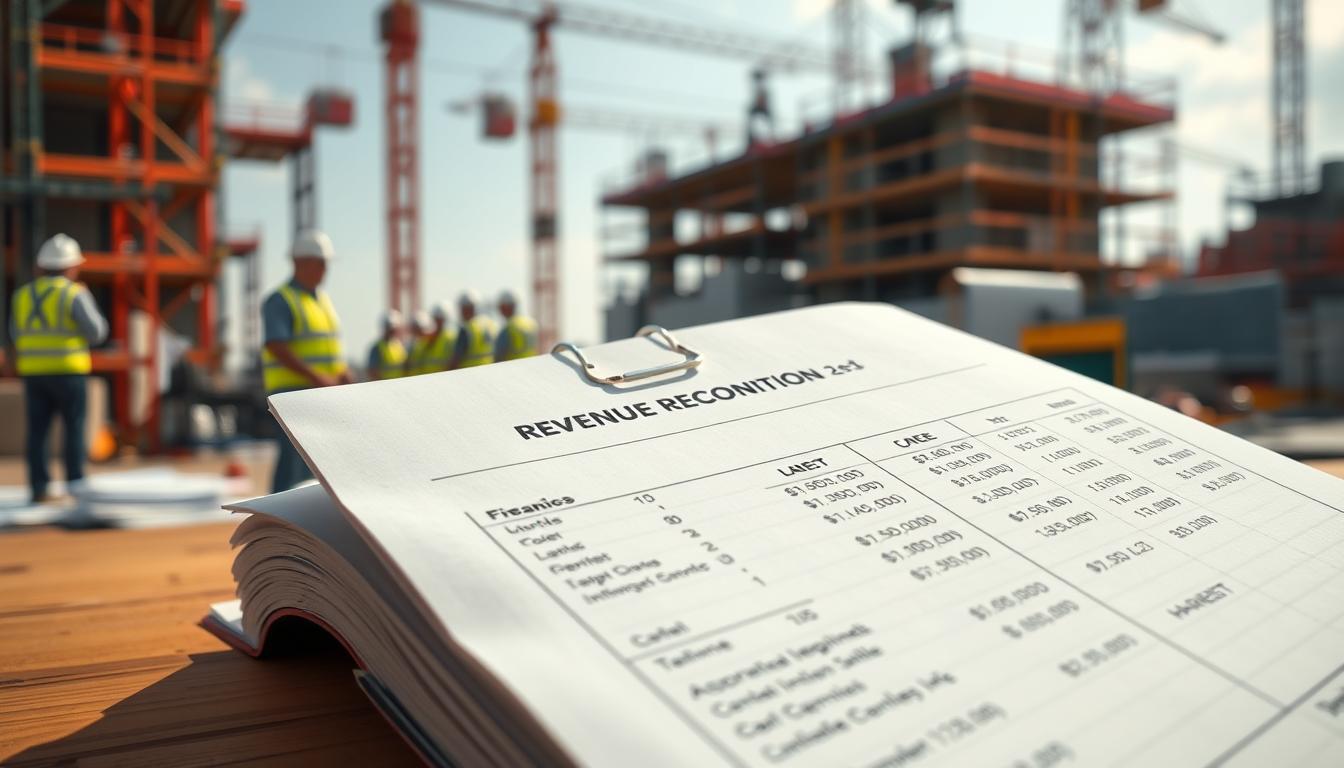Mastering Revenue Recognition in Construction: A Complete Guide for Construction Companies

The construction industry faces unique challenges in revenue recognition. This is due to its project-based nature, long-term contracts, and fluctuating costs. Projects can last for years, making it essential for companies to master revenue recognition. This ensures financial clarity, compliance with standards, and accurate profitability representation.
The construction industry has a high failure rate, with many companies failing to reach 10 years. Accurate financial reporting is vital for success and longevity. Metrics like gross profit margin, overhead ratio, and net profit margin offer insights into financial health. The average gross profit margin is 10% to 20%, and the net profit margin is 2% to 5%.
Cash flow management is critical for construction companies. The cash conversion cycle can be over 60 days. Retainage, typically 10% of payments, can equal the expected net profit. Overbilling and underbilling practices also affect cash flow and need monitoring through WIP reports.
Accounting firms can guide construction companies through revenue recognition complexities. They assess current practices, implement frameworks, and offer ongoing advice. Specialized construction accounting software can also help with job costing, WIP reporting, and other financial processes.
Key Takeaways
- Revenue recognition in construction is complex due to project-based work and long-term contracts.
- Financial metrics like gross profit margin, overhead ratio, and net profit margin are critical for assessing a construction company’s health.
- Cash flow management is challenging in construction, with long cash conversion cycles and retainage practices.
- Overbilling and underbilling impact cash flow and require monitoring through WIP reports.
- Accounting firms and specialized software can help construction companies master revenue recognition and streamline financial processes.
Introduction
In the world of construction accounting, grasping revenue recognition is key for clear financials and adherence to rules. The long-term nature of construction projects and varied timelines complicate accurate revenue recognition. By learning the essential principles and best practices, construction firms can overcome this hurdle. They can then ensure their financial reports are both trustworthy and open.
Understanding Revenue Recognition in Construction
The construction industry’s project-based work and long contracts set it apart from others. The Financial Accounting Standards Board (FASB) and the International Accounting Standards Board (IASB) have developed ASC 606 and IFRS 15. These standards aim to standardize revenue recognition across all sectors. They require revenue to be recorded when performance obligations are met, not when payment is received.
Why It Matters: Financial Clarity & Compliance
Accurate revenue recognition is essential for a clear financial picture in construction. It affects income, balance, and cash flow statements. Recognizing revenue too early can inflate profits, while recognizing it too late can deflate them. Staying in line with accounting standards and regulations, like GAAP in the US and IFRS worldwide, is critical. It prevents misstating revenue and deceiving stakeholders.
How Accounting Firms Can Help Construction Companies Navigate Revenue Recognition
Accounting firms are vital in guiding construction companies through revenue recognition complexities. They offer customized solutions and deep insights into construction accounting. This helps in applying the five-step revenue recognition model from ASC 606. Steps include identifying contracts, determining transaction prices, and recognizing revenue when obligations are fulfilled. They also aid in optimizing financial reporting, ensuring compliance, and streamlining revenue recognition with tools like Sage 300 Construction.
The Fundamentals of Revenue Recognition
Revenue recognition is a key part of financial reporting for construction firms. It records revenue when it’s earned, not when payment is made. This approach ensures financial statements accurately reflect the company’s performance and meet accounting standards.
The revenue recognition principle states that revenue is recorded when it’s realized and earned, regardless of cash receipt timing. For construction firms, this means recognizing revenue as construction costs are incurred and project progress is made. This is instead of waiting until the project is finished and payment is received.
Key Accounting Standards: ASC 606 & IFRS 15
To comply with accounting standards, construction companies must follow guidelines from the Financial Accounting Standards Board (FASB) and the International Accounting Standards Board (IASB). In May 2014, these boards jointly issued ASC 606 and IFRS 15. These standards provide a detailed framework for revenue recognition.
These standards mandate a five-step model for revenue recognition. This includes identifying the contract, determining performance obligations, establishing the transaction price, allocating the price to obligations, and recognizing revenue as obligations are satisfied.
The Five-Step Model for Revenue Recognition
The five-step model for revenue recognition aligns with various accounting methods in the construction industry. This includes the percentage of completion method and the completed contract method. By following this model, construction companies can ensure their revenue recognition practices are consistent and meet accounting standards.
- Identify the contract with the customer
- Identify the performance obligations in the contract
- Determine the transaction price
- Allocate the transaction price to the performance obligations
- Recognize revenue when (or as) the entity satisfies a performance obligation
Proper revenue recognition is vital for construction companies to provide accurate financial information. It helps make informed business decisions and ensures compliance with accounting standards. By grasping and applying the fundamentals of revenue recognition, construction companies can achieve long-term success and financial stability.
Revenue Recognition Methods in Construction
Construction firms face various options for recognizing revenue. The choice hinges on contract terms, project length, and the ability to measure progress. Adopting the best practices for construction revenue recognition policies is vital. It ensures accurate revenue recognition and financial transparency.
The accrual accounting method is prevalent in construction, recording revenue and expenses as work is done, not when cash is received. This approach offers a clearer financial picture than the cash basis method, suitable for small businesses with under $30 million in annual revenue as of 2024.
Percentage of Completion Method (PCM)
The percentage of completion method (PCM) bases revenue on project progress. It’s ideal for long-term projects, allowing contractors to recognize revenue as work is finished. Revenue is calculated by multiplying the project’s total revenue by the percentage of completion.
Completed Contract Method (CCM)
The completed contract method (CCM) delays revenue and expense recognition until a contract is fully completed. It’s best for short-term projects, usually under a year. CCM can cause financial statement volatility but helps contractors defer taxes if the project extends into the next tax year.
Milestone-Based Revenue Recognition
Milestone-based revenue recognition ties revenue to specific project milestones. Contractors can recognize revenue at each milestone, not just by time or costs. This method is beneficial for projects with clear stages and deliverables.
Cost-Recovery Method
The cost-recovery method focuses on recovering costs before recognizing profits. Revenue is recognized only after costs are fully recovered. Once costs are back, any additional revenue is seen as profit. This method is common in risky projects or when total revenue is uncertain.
Contract Types & Their Impact on Revenue Recognition
Construction contracts come in various forms, each with its own set of rules. These differences significantly influence how companies report their revenue. Grasping the specifics of each contract type is essential for effective construction accounting. This knowledge is key to accurately tracking revenue. Let’s dive into the most prevalent contract types and their financial reporting implications.
Fixed-Price Contracts
Fixed-price contracts require a company to complete a project for a fixed fee. Revenue is recognized based on the percentage of completion. This method offers a clearer financial picture as the project advances.
Cost-Plus Contracts
Cost-plus contracts cover all project costs plus a profit margin. Revenue is recognized as costs are incurred. This approach is vital for managing projects with unpredictable expenses.
Time & Materials Contracts
Time and materials contracts charge clients for actual labor and materials used. Revenue is recognized as work is done. This method aligns effort with financial outcomes, a cornerstone of successful construction management.
Unit-Price Contracts
Unit-price contracts set a price per unit of work, like concrete or flooring. Revenue is tied to work completed, making it easier to track. This type is ideal for projects with clear scopes and measurable outcomes.
Understanding the revenue recognition rules for each contract type is critical. It enables companies to make informed decisions, maintain accurate financial records, and adhere to accounting standards. Collaborating with seasoned accounting professionals is essential. They help navigate the complexities of revenue recognition, ensuring long-term success in the construction industry.
Identifying Performance Obligations in Construction Contracts
For construction companies, grasping performance obligations is key to precise revenue recognition and adherence to accounting standards. These obligations represent the distinct goods or services a contract promises. They can range from a single item to multiple items, even if not explicitly listed. Accurately pinpointing these obligations is vital for determining when and how to record revenue in construction accounting.
Construction deals frequently encompass multiple performance obligations, with studies showing about 70% of contracts include separate deliverables. These can span from installation services to manufacturing materials, purchasing equipment, and maintenance agreements. It’s imperative to correctly identify and separate these obligations for accurate revenue recognition and to meet standards like ASC 606.
Single vs. Multiple Performance Obligations
Construction contracts can either have a single obligation, like building construction, or multiple ones, such as design, construction, and maintenance. Over 70% of contracts involve goods or services that are deeply interdependent, leading to a single obligation. Yet, about 30% of contracts have customer options for additional goods or services, which are treated as separate obligations.
Recognizing Revenue for Bundled Services
Bundled services in construction accounting can make revenue recognition more complex. The transaction price must be split among each performance obligation. For instance, an IT company providing a software license, installation, updates, and support would have four obligations. To recognize revenue for these bundled services, a detailed analysis and allocation of the transaction price to each obligation based on standalone selling prices are required.
Challenges in Determining Performance Obligations
Identifying performance obligations in construction contracts can be daunting, mainly when obligations are unclear or interdependent. About 50% of construction firms face challenges in identifying these obligations due to contract complexity. Determining the distinct nature of goods and services requires judgment, varying greatly across projects. Reports show that effective management of performance obligations can boost compliance with revenue recognition standards by 15%, underscoring their critical role in construction payroll and accounting.
Measuring Progress Toward Completion
Accurately measuring progress toward completion is key when using the percentage of completion method for revenue recognition in construction projects. This ensures revenue is recognized in proportion to the work done. It provides a clear financial status of the project.
There are two main ways to measure progress: input methods and output methods. Input methods, like the cost-to-cost method, measure progress by comparing resources used to total estimated costs. For example, if $75,000 in costs have been incurred out of a total of $100,000, the project is 75% complete. Revenue can then be recognized.
Cost-to-Cost Method
The cost-to-cost method is a common input method. It compares actual costs to total estimated costs. This method is useful when costs and progress are directly related throughout the project.
Labor-Hours Method
The labor-hours method tracks labor hours spent versus total estimated hours. It’s ideal for projects where labor is a major factor and directly relates to progress.
Units of Delivery Method
Output methods, like the units of delivery method, measure progress by comparing work done to total work required. For example, if 75 out of 100 units have been completed, the project is 75% done. Output methods are best when each unit’s value is consistent.
The choice between input and output methods depends on the project’s nature and data reliability. Management must decide if the chosen method accurately reflects goods or services transfer to the customer. They should also consider if material performance between milestones is captured.
Retainage & Its Effect on Revenue Recognition
Retainage is a common practice in the construction industry. It involves withholding a portion of the contract price until the project is substantially complete. This practice protects the customer and motivates the contractor to ensure quality work. Typically, retainage ranges from 5% to 10% of the total contract value.
What Is Retainage?
Retainage is a sum of money withheld from progress payments in construction contracts. It is held by the customer until the contractor completes the project to their satisfaction. This practice ensures the contractor meets contract specifications and addresses any defects or issues.
How Retainage Affects Financial Reporting
Retainage impacts financial reporting by creating a gap between work performed and revenue recognized. The Financial Accounting Standards Board (FASB) ASC Topic 606 defines a receivable as an unconditional right to consideration. It classifies retainage as a receivable only when payment is contingent on time passage.
In long-term construction contracts, retainage is often conditional on future obligations and performance metrics. Retainage receivable is recorded as an asset, while retainage payable is recorded as a liability. The construction industry often has extended operating cycles, leading to the classification of contract assets and liabilities as current.
Recognizing Revenue with Retainage Held
Revenue related to retainage is recognized when it is billable. This can be upon substantial completion or after a specified period. Topic 606 requires contract asset and liability positions to be determined on a net basis at the individual contract level. The cost-to-cost input method is commonly used for long-term construction contracts under Topic 606 for recognizing revenue.
Legacy GAAP excluded retainage from costs and estimated earnings in excess of billings on uncompleted contracts. Transitioning to the terminology of contract assets and liabilities is recommended to avoid confusion in financial statements. The presentation of retainage, receivables, contract assets, and contract liabilities can vary, with significant information often provided on the balance sheet or in footnotes.
Overbilling & Underbilling: A Revenue Recognition Dilemma
In the construction sector, overbilling and underbilling can drastically affect your company’s cash flow and financial reports. Overbilling happens when you bill more than the work’s value, leading to a liability called “billings in excess of costs.” On the flip side, underbilling occurs when you earn more than you bill, creating an asset called “costs in excess of billings.”
Understanding Overbilling & Underbilling
Let’s consider a scenario to understand overbilling and underbilling. Imagine your construction company is on a $500,000 project. After a month, you’ve completed 30% of the work, earning $150,000. Yet, you’ve billed the client $200,000. This means you’ve overbilled by $50,000, showing as a liability on your balance sheet.
Impact on Cash Flow & Financial Statements
Overbilling can boost your short-term cash flow, as you get paid for work not yet done. Yet, it might lead to revenue adjustments and client disputes later. Underbilling, on the other hand, can strain your cash flow, as you’ve earned revenue without payment. It signals future revenue to be recognized when invoiced.
Both scenarios impact your financial statements. Overbilling increases liabilities, while underbilling boosts assets. It’s vital to track and manage these differences to ensure accurate financial reports and avoid cash flow problems.
Best Practices to Mitigate Risks
To reduce risks from overbilling and underbilling, follow these best practices:
- Match your billing with work progress to reduce errors.
- Keep an eye on unbilled costs and invoice promptly to avoid underbilling.
- Communicate clearly with clients about project status and billing to avoid misunderstandings.
- Implement strong internal controls, like segregation of duties and audit trails, to prevent fraud.
- Comply with contract terms and accounting standards, like ASC 606, to ensure accurate and legal billing.
Understanding the effects of overbilling and underbilling on your construction company’s finances helps make better revenue recognition decisions. This way, you can maintain financial stability.
The Impact of Taxation on Revenue Recognition
For construction companies, grasping the tax implications of revenue recognition is vital. The timing and method of revenue recognition can greatly influence tax liabilities. This makes tax planning a critical part of financial management.
Revenue recognized is subject to income tax in the period it’s reported. This might not match when cash is received. This discrepancy can lead to deferred tax assets or liabilities. These deferred taxes affect your cash flow and financial planning.
Tax Treatment of Recognized Revenue
The Tax Cuts and Jobs Act (TCJA) of 2018 changed revenue recognition rules under Sec. 451. Now, accrual-method taxpayers must recognize revenue when it’s due, earned, received, or reported in a financial statement. The IRS issued final regulations in 2020. These must be implemented by tax years starting on or after Jan. 1, 2021.
Deferred Tax Implications
Temporary differences in accounting for financial reporting and income taxes may occur due to the new revenue recognition standard. This can lead to deferred tax assets or liabilities. These affect your company’s cash tax position and income recognition timing. The final regulations under Sec. 451 provide guidance on handling these tax implications.
Sales Tax Considerations in Construction Projects
Construction companies must also consider sales tax on materials and services. Sales tax rules vary by jurisdiction, adding complexity to tax planning. Revenue that was once considered product revenue might now be seen as service revenue. This changes sales or excise tax calculations.
To effectively manage these tax implications, construction companies should collaborate with accounting and tax advisors. Proper tax planning and compliance can prevent penalties, optimize cash flow, and ensure long-term success.
How an Accounting Firm Can Assist with Revenue Recognition
Revenue recognition in the construction industry is complex. An experienced accounting firm can offer significant help. They ensure compliance with accounting standards and implement best practices. They assess your current practices, identify areas for improvement, and create a tailored framework for your company.
Assessing Your Current Practices
Optimizing revenue recognition starts with assessing your current practices. An accounting firm reviews your GAAP memos, financial reports, and industry practices. They look for gaps and risks. They also check your manual and system processes for effectiveness and staff competency.
Implementing a Robust Framework
After assessing, an accounting firm implements a strong revenue recognition framework. This aligns with standards like ASC 606 and IFRS 15. They provide training, recommend process changes, and create customized solutions for your projects.
Ongoing Compliance and Advisory Services
Staying compliant with revenue recognition standards is an ongoing task. An accounting firm continuously monitors and adapts to changes. They offer guidance on complex issues, help draft GAAP memos, and ensure accurate financial reports.
Customized Solutions for Complex Projects
Construction projects have unique challenges. An accounting firm develops tailored revenue recognition solutions. These ensure accurate and efficient processes for your complex projects.
Partnering with an accounting firm for revenue recognition services improves your financial reporting. It also reduces risks from improper revenue recognition.
Summary
Mastering revenue recognition is vital for construction firms to achieve financial clarity and adhere to standards like ASC 606 and IFRS 15. The construction sector faces unique hurdles due to contract complexities, varied project durations, and the necessity to accurately gauge progress. By employing the right revenue recognition methods, such as the percentage of completion or the completed contract method, companies can align their financial reports with project realities.
Accurate revenue recognition requires identifying contract obligations, determining the transaction price, and allocating it to each obligation. Construction entities must meticulously evaluate factors like retainage, overbilling, and underbilling to ensure precise financial reporting and cash flow management. Tax implications, including deferred taxes and sales taxes, also play a significant role in revenue recognition.
Collaborating with a seasoned accounting firm can greatly aid in navigating revenue recognition complexities in construction. These firms can evaluate current practices, establish robust frameworks, and provide ongoing compliance and advisory services. By excelling in revenue recognition, construction companies can improve their financial management, reduce risks, and thrive in a competitive market.
FAQ
What makes revenue recognition in construction different from other industries?
Construction’s project-based nature and long-term contracts set it apart. These contracts span multiple accounting periods. Fluctuating costs add to the complexity of determining revenue recognition.
Why is mastering revenue recognition important for construction companies?
It ensures financial clarity and compliance with standards like ASC 606 and IFRS 15. This clarity is vital for accurately portraying profitability and financial health.
What are the key accounting standards for revenue recognition?
ASC 606 (US GAAP) and IFRS 15 (International Financial Reporting Standards) are key. They guide on recognizing revenue through a five-step model.
What are the common revenue recognition methods used in the construction industry?
Methods include the percentage of completion, completed contract, milestone-based, and cost-recovery methods. The choice depends on contract terms, project duration, and progress measurement.
How do different contract types impact revenue recognition in construction?
Contract types significantly influence revenue recognition. Fixed-price contracts recognize revenue based on completion. Cost-plus contracts reimburse costs plus profit, recognizing revenue as costs are incurred. Time and materials contracts bill for labor and materials, recognizing revenue as work is done. Unit-price contracts recognize revenue based on quantities completed.
What are performance obligations, and why are they important in construction contracts?
Performance obligations are distinct goods or services in a contract. Identifying them is key to determining revenue recognition. Contracts may have one or multiple obligations, like design and construction.
How is progress towards completion measured in construction projects?
Progress is measured by input or output methods. Input methods, like cost-to-cost or labor-hours, compare resources consumed to total costs or hours. Output methods, like units of delivery, compare work accomplished to total work.
What is retainage, and how does it affect revenue recognition?
Retainage is a withheld portion of the contract price until completion. It affects financial reporting by creating a gap between work and revenue recognized. Revenue from retainage is recognized when billable, often upon substantial completion.
What are overbilling and underbilling, and how do they impact financial statements?
Overbilling creates a liability, “billings in excess of costs.” Underbilling creates an asset, “costs in excess of billings.” Both affect cash flow and financial statements.
How can an accounting firm assist construction companies with revenue recognition?
An experienced accounting firm can assess current practices and improve them. They develop a framework aligned with standards and best practices. They offer ongoing services, including compliance monitoring and guidance on complex issues. Customized solutions are available for unique projects.








